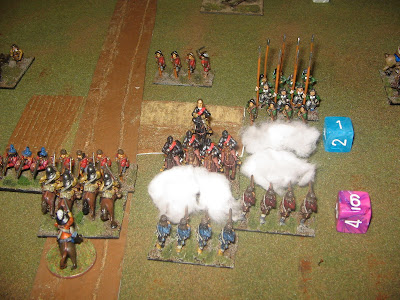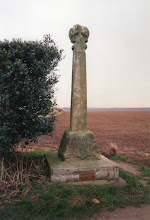Historically, the stand-off between the two armies at Turnham Green was at best a stalemate for Charles, and probably is better characterised as a defeat. After avoiding an engagement at Turnham Green:
Charles (once more contrary to Rupert's advice) retreated back up the Thames Valley towards Oxford (losing the possible chance for a flanking movement through loyal Kent), where Charles set up his headquarters for the rest of the war. Never again during the Civil War would the Royalists come as close to capturing London and without London they could not win the war. (http://en.wikipedia.org/wiki/Battle_of_Turnham_Green)However, in this last battle of this 1642 DBA-RRR campaign, Rupert's initiative and determination to press home his successes in the Thames Valley effected quite a different outcome. The battle opens with the two armies arrayed in the common form in the 17th century – foot to the centre and cavalry on the flanks – in the open space formed by Turnham Green, Acton Green and Chiswick common field.
With the end of the campaigning season approaching, the fields of Middlesex were wet and Charles' army, under the commend of the Earl of Forth, stood amongst the enclosures near Sutton court, with boggy ground to its rear. Essex drew up his army between the Great West Road and Chiswick Village, his troops taking what cover they could from the enclosures around Home Field.
 |
| The Royalists (foreground) deploy on Turnham Green |
As the foot advanced in the centre, the Royalist cavaliers swept out along the road to London threatening the lesser force of cavalry on the Parliamentarian right flank. Seeking to seize back some of the initiative, Essex ordered a general advance out of his defensive positions onto the Green. Essex's cavalry formed a line to meet the advancing cavaliers and his shot, which outnumbered their Royalist opponents, wheeled menacingly towards the Royalist right. Rupert ordered his dragoons out wide to reduce the risk of the artillery at Chiswick House being flanked.
The resolute charge by Charles' cavaliers broke and scattered the cavalry on the Essex's extreme right and pushed back the others leaving the commander's Lifegaurd of heavy cavalry surrounded and hard pressed. Essex ordered his Lifegaurd to withdraw fearing they would be surrounded. Meanwhile the Royalist foot in the centre was kept from closing by the furious cannonade. Charles ordered his heavy cavalry into the centre with orders to silence the Parliamentarian guns.
With his right flank collapsing Essex ordered his foot to push hard on the left. Parliament's shot advanced into musket range engaging the Royalist foot and artillery outside Chiswick House hoping to turn the tide with their greater numbers. Musketry clattered as both lines gave fire. Smoke bit at the eyes of the musketeers and lead tore at flesh. Despte their resolute advance Essex's foot faltered with an entire regiment decimated in the centre of their line. The Royalist dragoons rode in at bit at the heels of the Parliamentarians as they fell back in disorder.
The cavaliers on the King's left flank continued to press hard seeking to surround and destroy Essex's Lifegaurd. But this was not without cost as Parliament's heavy cavalry stood firm and shattered a charge to their front, decimating a cavalry regiment. With the initiative firmly with the King, the collapse in command among Essex's forces left the artillery in the centre at the mercy of the King's heavy cavalry as the heavy foot fell to the push of pike. Amidst the chaos in the Parliamentarian ranks, Essex's Lifegaurd were surrounded by a final charge of the King's cavaliers. Despite repeated countercharges with their pistols spewing fire and lead, they were annihilated (note the 6-6 close combat roll!). Essex, now commanding the last regiment of calvary on the field, held his ground protecting the flank of the Parliamentarian foot from utter destruction as it fell back in disorder and finally routed from the field.
Charle's army had decisively defeated Essex (1:4 elements lost) and with the campaigning season almost at an end, decided to march his army south with the aim of overwintering among rich countryside of Kent to reinforce and reequip his troops for the final push on London in the Spring of 1643.
Here ends this DBA-RRR 1642 mini-campaign. While the outcome at Turnham Green would suggest a decisive Royalist victory, the victory conditions should be consulted to reassure the reader of this result.














































